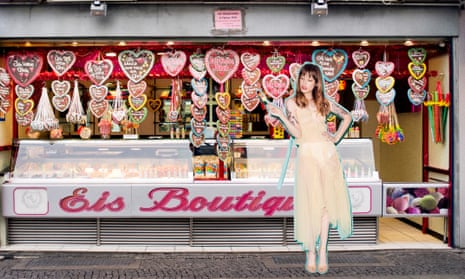Flavour of the season
Next time you’re tucking into an ice-cream cone, think of the sweet treat’s illustrious history. Charles II served it at the Garter Banquet in 1671, reserving the cold delight for the royal table alone. Before that, it was the fashionable dessert for wealthy Florentines, with Catherine de’ Medici bringing it to Versailles when she married King Henry of France in 1533. George Washington was also a fan. In the summer of 1790, he spent $200 on ice-cream – a lot, even by today’s standards – and apparently preferred the now-defunct oyster flavour.
More recently, ice-cream has been enjoyed by ordinary folk, too. See the story (or urban myth) that Margaret Thatcher helped Mr Whippy with a new technique adding air to the formula to make the so-called soft-serve you find in the classic 99.
Why all the ice-cream facts? Because its fashion’s favourite treat this season. Not to eat, of course. In an industry in which the benefits of a plant-based diet are increasingly the alpha chat on the front row, it’s more about the look of ice-cream. The colours have been translated to blazers, dresses, trousers and more. Try a jacket the colour of strawberry ice-cream at Céline, pistachio co-ords at Acne, vanilla wafers on a suit at Chanel, blueberry swirls in a skirt suit at Versace or violet cream in layers of organza at Preen. It’s lip-smackingly good, and calorie-free.
Ice-cream is uncomplicated, sweet and speaks of summer, of wandering without knowing the time, of holidays and smiles. In a world in which opinion is often divided, and right and wrong bitterly contested, ice-cream feels like something to agree on. I scream, you scream, we all scream for ice-cream. Maybe that is why we want to dress like an ice-cream this season.
To make sure your take on ice-cream is selfie-ready, Google the Museum of Ice Cream. A pop-up event that’s been staged across the US, this place is dedicated to the look, if not the taste, of everyone’s favourite frozen dessert; there is a plunge pool of sprinkles, a gummy bear room and one with foam bananas on the ceiling. It’s popular on Instagram – 329,000 followers and counting – with Beyoncé, Drew Barrymore and Kim Kardashian posting snaps of their visits. The museum is yet to come to the UK. While you wait, there’s time to match your wardrobe to your favourite flavour – or three.
Heron Preston keeps it real

Styling Melanie Wilkinson Hair Shukeel at Frank Agency using Hair by Sam McKnight Model Tawan at Storm Retouching Frisian. Photograph: David Newby/The Guardian
Heron Preston is a man who lives life at breakneck speed. At 34, the designer, DJ and influencer is still relatively unknown by the wider fashion industry, but Kanye West, Off-White’s Virgil Abloh and Nike dot his CV. He launched his own line only last year, but has already persuaded the New York Department of Sanitation to collaborate with him on a collection using upcycled workwear. (Clearly quite the negotiator, he approached them, W magazine says, with an email titled “Big idea”.) “It’s so weird but it makes so much sense,” he says. “There’s lots of similarities in what they wear and what I wear.”
The Heron Preston aesthetic, as seen in his second collection, for S/S 18, is bold colour, graphic print and 90s details such as bumbags and high-waisted jeans. Things that could easily walk into the wardrobe of a young hypebeast. The buzz is because “people want things that come from a real place. That’s what gets under my skin.”
Preston grew up in San Francisco and was printing T-shirts by the age of 18. He moved to New York to study design and management at Parsons School of Design. “I thought I wanted to be a fashion designer but I didn’t want to learn to sew,” he says. “I wanted to get my ideas out there.” He believes this is how the younger generation is thinking: “There’s a new class creating their own rules. You’re going to see that much more with the bitcoin generation.”
Preston is an inspiration to those coming next, especially as an African-American designer on the rise. “I don’t see colour like that but, yes, I am a black straight man in the fashion industry,” he says. “It’s important for kids to know that is possible.”
For him, the sky is the limit. “I’m using fashion to get out of fashion,” he says. “Heron Preston is a lifestyle brand.”
Loewe loses its heart to craft
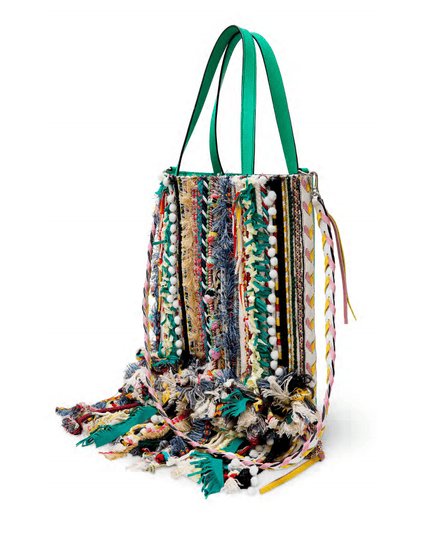
Photograph: Loewe
If two gongs at December’s Fashion Awards didn’t convince you of Jonathan Anderson’s impeccable taste, his craft range for Loewe will. It comprises 50 blankets, tapestries and shoppers made in collaboration with craftspeople in Japan, Togo, Peru, India and Spain. There’s a bag with imagery from the Andes and a blanket fashioned from Indian ribbon embroidery. On show at Milan’s design fair Salone del Mobile in April, the totes will go on sale later this year. Craft has never been so chic.
Burberry check reborn

Styling Melanie Wilkinson Makeup Lisa Stokes using Victoria Beckham Estée Lauder Hair Shukeel at Frank Agency using Hair by Sam McKnight Model India at Milk Retouching Frisian.
Photograph: David Newby/The Guardian
Before Christopher Bailey announced that he was leaving Burberry, he was keen to make us feel nostalgic for the label’s historic past. And so, 15 years after the infamous beige check became an object of derision, and Burberry itself buried the print in the lining of its trenchcoats, he has brought check back. The renaissance has been achieved through a few factors: Adwoa Aboah in a checked baseball cap, a collaboration with Gosha Rubchinskiy and a series of plastic-y macs that have become an Instagram influencer favourite. Now there’s a mid-season collection that is check-tastic, too. Those trademark squares appear on see-through bags, dresses and macs, plus the kind of shirts and caps that will appeal to both long-term fans and more recent adopters in search of the perfect street style shot. The check is back and no one does a check like Burberry. Dive in.
Loq steps up
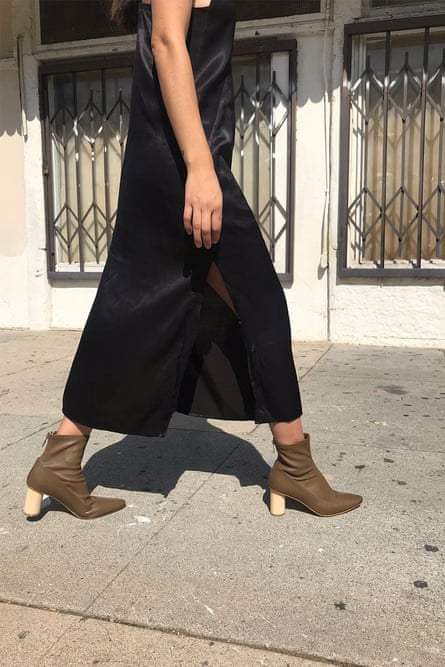
Combine the surnames of Keren Longkumer and Valerie Quant and you have Loq, a new footwear label designed in Los Angeles and India’s Nagaland, and built in Spain. The aim is “to redefine classics” and the results are a slick take on ultra-minimal Indian footwear, in pleasing tactile shades of khaki and cream. Think both simple and architectual. Longkumer and Quant met on a footwear course in LA in 2015; they now live in Nagaland and LA’s Venice Beach respectively, but their long-distance relationship provides umpteen references to keep their designs fresh.
Telfar Clemens ups the ante
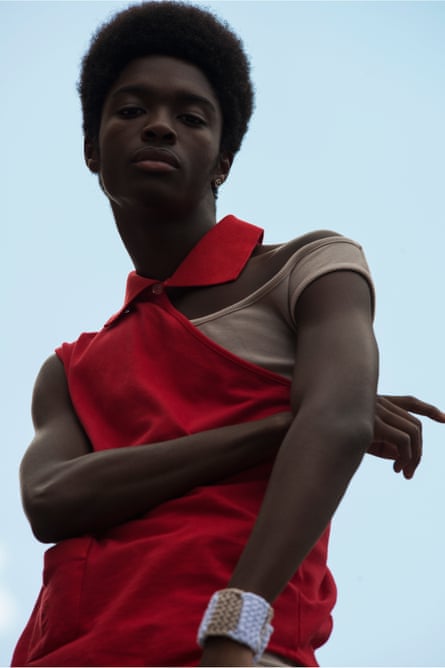
“‘Unisex’ and ‘diversity’ were not buzzwords in fashion in 2005,” says designer Telfar Clemens of the year he launched his unisex brand, ahead of the curve, at just 18. Two decades on those words do not so much buzz as reverberate – cue Telfar’s long-awaited rise in 2017, and the label clinching the $400,000 (£283,000) CFDA/Vogue Fashion Fund in November.
The temptation is to call his designs “elevated” casualwear, but Clemens prefers “horizontal” which, he says, reflects his ethos that Telfar doesn’t just support diversity, but is diverse in its work – he recently designed the uniforms for US fast food chain White Castle, for example, which are now sold online to support the Robert F Kennedy human rights fund to pay bail for minors held on Rikers Island.
Clemens intends to up the ante in 2018. “There is a lot of insecurity in fashion now,” he says, “and there’s a chance the way we already do things – if we can scale them up – could represent a new way forward.”
Like a rhinestone cowboy
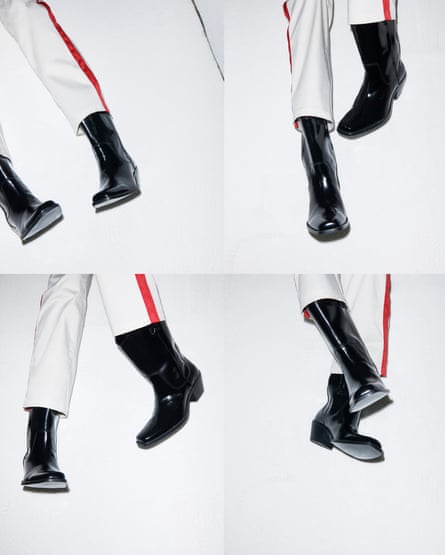
Styling Melanie Wilkinson Model Tawan at Storm Retouching Frisian. Photograph: David Newby/The Guardian
Cowboy boots are S/S 18’s breakout footwear, but how would you fare if your Mastermind subject was what you’ll wear on your feet this season? Time for five facts.
1 Despite Calvin Klein, Chloé, Coach et al conjuring their own takes on the trend, in the cowboy boot world there are officially only two types. The original Western has to be at least mid-calf length, the new Roper just above the ankle, meaning they are more easily removed in the rodeo.
2 Cowboy boots’ exaggerated V-shaped toe appeared only in the 40s, before which a round toe made it easier to slide into a stirrup. A substantial heel was also about safety: the higher the heel, the more leverage a rider had, and the less chance of coming off should they find themselves riding Buckaroo.
3 The Western’s tall shaft was designed to protect the wearer from thorns, bushes or filling up with mud or water. This season’s trend also comes with a conversation starter: the oft-used phrase “Giddy up” derives from “Get thee up”. You’re welcome.
4 The most expensive (and least Peta-friendly) boots ever went for $106,000 (£75,000) in 2010. Called the Phantom Boots, they were made by Montana-based Howard H Knight with saltwater crocodile from the Hermès factory, were lined in black kangaroo and decorated with 18 carat white gold-studded floral carvings.
5 Until 2018, the list of famous cowboy boot fans was pretty eclectic – Kate Moss, Victoria Beckham, George W Bush and Taylor Swift among them. The most trivia-worthy, however, is Arnold Schwarzenegger, who confesses to having more than 15 pairs. “It is a hobby that requires a little work,” he captioned an image of him tending to his collection on his Facebook page.
Frida Kahlo: artist and style icon

“I am my own muse, I am the subject I know best. The subject I want to know better,” said Frida Kahlo. This summer we’ll all get the chance to do just that, as an exhibition of clothes, photographs, paintings and possessions, some of which have never before left her native Mexico, opens in London. The artefacts were only discovered in 2004, when a sealed room in the Blue House – Kahlo’s home with her husband, Diego Rivera, in Mexico City – was opened. He had requested it stay sealed for 15 years after his death in 1957, but it remained closed for 47.
The exhibition will offer a chance to see, in glorious detail, the elaborately embroidered traditional Mexican dresses and exquisite hand-painted corsets that established Kahlo as one of the 20th century’s most enigmatic style icons.
Frida Kahlo: Making Her Self Up opens at the V&A, London SW7, in June.
Coach ♥ Keith Haring
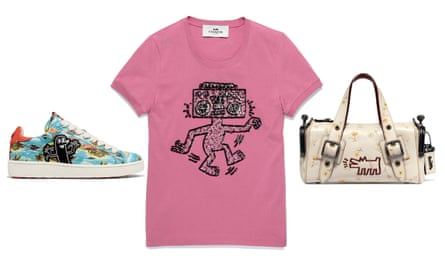
Composite: Keith Haring/Artestar NY
Stuart Vevers of Coach says the best collections come from letting your mind wander. “You start just playing with ideas and then something sticks in your head and you’re like, ‘I’m not sure this will be the same without this,’” he says. For S/S 18, the unmissable element was Keith Haring, the bespectacled, New York-based artist known for his bold graphic lines and crawling babies, who started his career with graffiti on subways in the 80s. Vevers worked with the artist’s foundation to use Haring’s work in sequins on T-shirts, sweaters and dresses.
The results are suitable for a customer who has one eye on her Insta-public and another on cool pop cultural references – a demographic that British-born Vevers has reached effectively since joining Coach in 2013. “It was important to me that we made something that felt fresh,” Vevers says. “I created a little story where I imagined a Coach girl walking through the subway with her cool 70s saddlebag and she sees Keith Haring creating his artwork and says, ‘Can you do that on my bag?’”
Despite dying, of Aids-related complications, at the age of just 31, Haring had a huge impact on making the art world less elitist during his short life. This makes him a good fit for Vevers. “He was quoted as saying, ‘Art is for everyone’ and I think Coach has that sense of inclusivity,” Vevers says. He likes to remember the artist in his prime, working on graffiti on the subway. “Those were my favourite moments,” the designer says, “seeing someone who is such a well-respected artist, nervously painting his work because he thinks he’s about to get arrested.”
PAM gets things in perspective
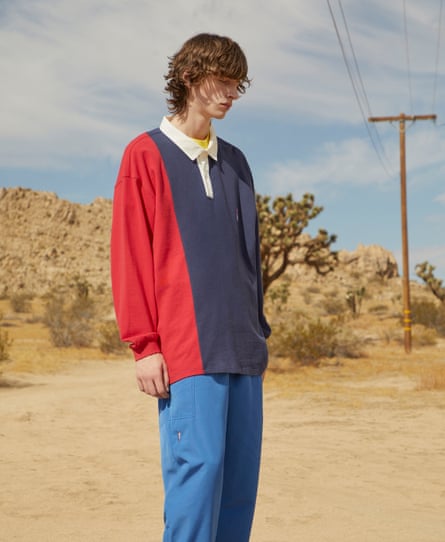
Melbourne lifestyle brand PAM is “pronounced Pam or P-A-M, either really,” says co-founder Misha Hollenbach. This is information you need to know now the brand is stocked at Matches Fashion. PAM stands for Perks and Mini, the graffiti names of Hollenbach and his partner, Shauna Toohey, who met as artists, got married and started their brand all in the same year, 2000. They produce everything: embroidered bombers, logo T-shirts and mixtapes – the clothes lean towards streetwear inspired by “food, politics, mythology and subcultures like German psych and the 70s graffiti movement”. Their aim is to “start a conversation”, to act as a subversive response to mainstream fashion, and “to not be too commercially-minded”. Naturally, the spring theme is “perspective” and is about seeing things differently. Conceptual indeed.
Sies Marjan: an instinct for design

Styling Melanie Wilkinson Makeup Lisa Stokes using Bobbi Brown Hair Shukeel at Frank Agency using Hair by Sam McKnight Model Chizoba at Milk Retouching Frisian. Photograph: David Newby/The Guardian
It’s not often that a designer cites Helmut Lang alongside Dolce & Gabbana, Raf Simons and Versace as their influences growing up, but then Sander Lak of Sies Marjan isn’t your typical creative. The 35-year-old attributes the success of his brand – which takes the first name of his father and mother respectively – to his open-minded approach and focus on a clear identity, common denominators of all the aforementioned houses. Now on his fifth season, he no doubt also takes influence from his own trajectory: Netherlands-born Lak was taught by visionary tutor Louise Wilson at Central Saint Martins, then worked with Phillip Lim, Christophe Decarnin at Balmain and Dries Van Noten.
“Everything is based on gut instinct and just knowing when something is right,” Lak explains. “I don’t have moodboards or themes – I find that old-fashioned and limiting. It’s confusing for the customer to have one poster girl one season and another the next.”
Lak prefers to conduct an organic design process with his 25-strong team, where his abstract fabric techniques and signature vivid palettes take centre stage. The colours (all created specifically for the label) at first divided opinion on the famously muted frow: “People said of the colour in our first collection, ‘It looks great but no one’s going to buy it!’” he remembers. Fast-forward to S/S 18 and Sies Marjan has caught the eye of international retailers, while in 2016 Beyoncé became the first celebrity to wear the brand. Lak’s conviction is essential, he says: “I’d rather fail doing what I want to do than succeed with something I’m not fully behind.”
The goth club
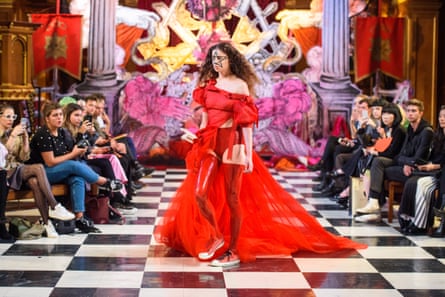
Agnostics, beware. If fashion is anything to go by, the occult is alive and well, at least symbolically, and it still has the power to shock. The kind of belief systems loved by those of a gothic bent were something of a trend among London designers this season. Dilara Findikoglu says she’s “into parapsychology and the occult and magic stuff”. She might not be a household name but her S/S 18 show in a London church, featuring a diverse, trans-friendly cast, pentagram facepaint and a set worthy of Aleister Crowley, scored her moral outrage courtesy of the Daily Mail.
There were spooky goings-ons elsewhere, too. Clio Peppiatt’s shiny robes used star signs, tarot cards and rams’ heads, while Ashish celebrated all things witchy, with stripy socks and a T-shirt that read “Idle hands are the Devil’s work”. The mood this season? Otherworldly.
Spotlight on the Sulky at Céline

Phoebe Philo might be departing Céline, but she left a parting gift in accessory form, reinventing Céline classic the Sulky – first launched in the 60s – for S/S 18. The updated version is all shiny leather and compact in size – it can be worn as a shoulder bag and carried as a clutch. It comes with the brand’s lesser-seen original horse-and-carriage hardware. All of this makes it an astute investment in a heritage house that’s about to embark on its next era. The brand says it symbolises “the past enriching the present” – we say it will make our future a better looking one, even without Phoebs.
All eyes on Alaïa

When searching for a subject for the first fashion exhibition for London’s new Design Museum, director Alice Black said Azzedine Alaïa was the perfect fit. “We were wondering what would be right for this striking building,” she says of the new Kensington site. “Alaïa is an out-of-the-ordinary fashion figure who stands apart from most of the industry.”
The exhibition, which opens in May, was partially organised with the input of the designer, before he died in November. Black had several meetings at his Paris atelier and says the staging is designed so that it is as Alaïa-approved as possible. “He was very clear about what he wanted and didn’t want to do without ever saying no,” she says. “Someone who knew him very well once said to me, ‘There’s no point trying to convince him – either he wants to do it or he doesn’t.’”
Alaïa kept himself at a distance from the industry that showed him so much love. Spurning the biannual calendar that ensures the fashion world moves like clockwork, he showed his collections when they were ready. Rather than the designer being ostracised, an Alaïa show became an event, something special. “He was a maverick without intending to be so,” Black says. “He’s so completely free in an industry that has so many codes.” Alaïa showed his final collection last year – with the previous one seven years earlier, in 2010.
Alaïa started his career in the 70s and found his signature style – what Black describes as “all about sculpting the female form” – early on. “It’s hard to pick a dress that is from the 80s or the 90s because he is incredibly consistent,” she says. Along with couture clients, the designer dressed everyone from Grace Jones to Tina Turner, Claudia Schiffer to Kim Kardashian. Naomi Campbell, whom he met as a teenager, stayed at his house in Paris and called him Papa. He also championed a more diverse selection of models, such as Campbell and Farida Khelfa.
This perhaps reflects the designer’s background. Alaia was born in Tunisia and came to Paris to work at Christian Dior. He would no doubt have come up against discrimination in his career. Black says this makes him even more impressive: “That he achieved what he did was through sheer determination. It would have been difficult but he transcended it all.”
Azzedine Alaïa: The Couturier opens at the Design Museum on 10 May.
